Shrubs are delicious fruit-infused drinks made using a syrup derived from fermenting fruit and herbs with honey and apple cider vinegar.
Shrubs have been enjoyed since the 15th century! The syrups were popular as medicinal cordials, and were also used in the American colonies to preserve the fruit harvest, since the fermentation process produces a flavorful syrup that keeps very well.
Like kombucha, shrubs are excellent for digestion, but they don’t require an added starter culture and are much easier to make.
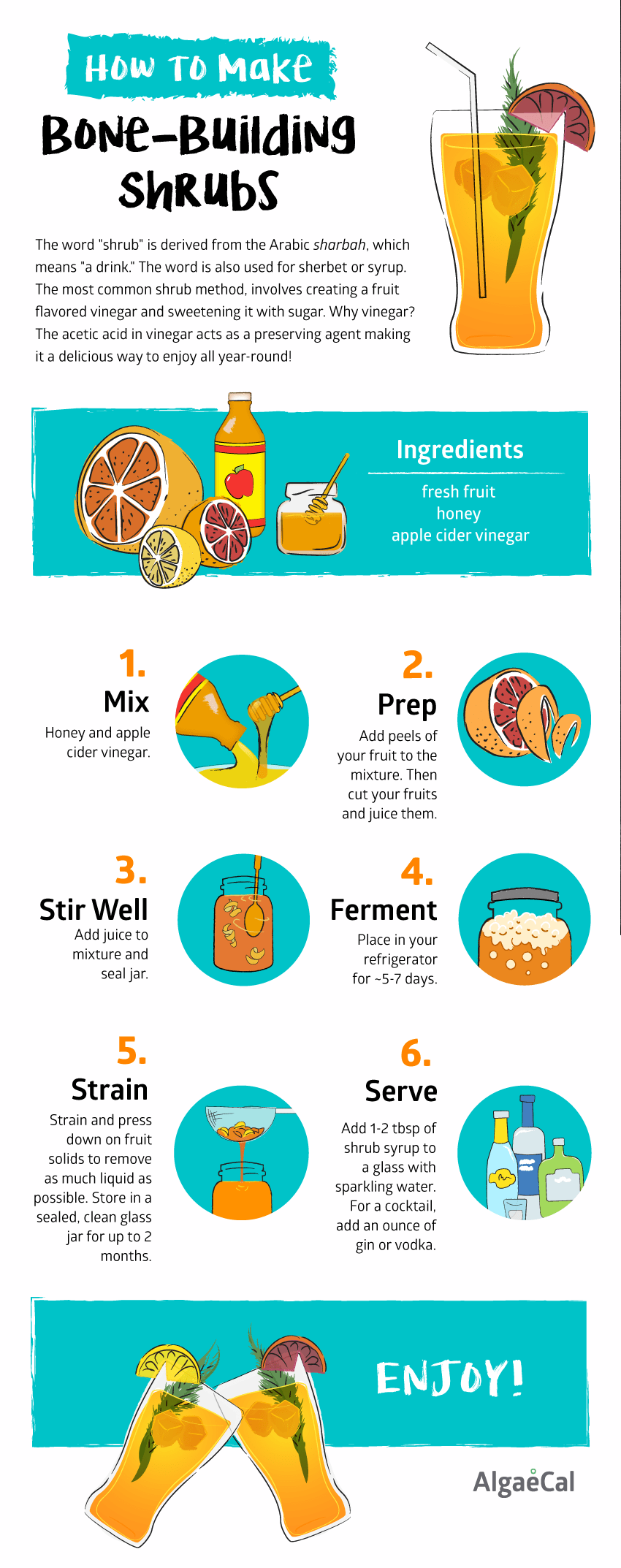
[embed_infographic title=”How to Make Bone-Building Shrubs” alt=”How to Make Shrubs infographic” src=”https://blog.algaecal.com/wp-content/uploads/how-to-make-a-shrub-infographic-3.png”]
My bone-building versions of traditional shrubs are made with syrups derived from the fermentation of organic fruits and herbs, raw honey, and organic unfiltered apple cider vinegar.
Organic fruits and herbs have a higher phytonutrient content than their conventionally grown cousins. Plus, organic produce does not contain pro-inflammatory, endocrine-disrupting pesticide residues.
Raw honey contains antimicrobial, anti-inflammatory compounds. And yes, while it is sugary honey, the fermentation process converts the sugars into carbon dioxide and give your shrubs a bit of fizz (bubbles).
You just add a tablespoon or two of shrub syrup to a glass of sparkling mineral water.
The result is a beautiful, tangy, low-calorie, mineral- and probiotic-rich, fruit-infused drink. Imagine, an elegant replacement for soda pop that builds bones!
The only drawback is that you must let your shrub syrup ferment in the refrigerator for 4-5 days to “develop.”
But the syrup you press out from the fermented fruits and herbs will keep in the refrigerator for a month (in the unlikely event you haven’t used it all up well before then!).
Following are recipes for a Citrus Ginger and a Tart Cherry-Anise-Hibiscus Shrub. Both produce beautiful syrups and are quick and easy to make.
Just add a few tablespoons of either syrup to sparkling mineral water, and you’ll have a visually beautiful, delicious, low-calorie, bone-building drink.
Shrubs’ Bone-Building Benefits
You may remember that I taped a video discussing research showing mineral waters are a good source of calcium. If you haven’t seen it, here’s the gist of what I reported:
Calcium-rich mineral water is a surprisingly good, calcium-rich alternative to milk. (My favorite brands are San Pellegrino or Gerolsteiner).
Our ability to absorb calcium decreases with age. However, the 1200 mg per day (which is recommended for women 51 years and older) may be difficult to accomplish, particularly for those who are lactose-intolerant or allergic to dairy products.
Fortunately, a number of studies have now shown that calcium-rich mineral waters can provide an easy, calorie-free alternative to cow’s milk.
A meta-analysis of 4 studies evaluated the bioavailability of calcium from calcium-rich mineral waters and also compared calcium absorption from mineral waters with that from dairy products.
The results showed that calcium bioavailability from mineral waters was at least as good as, and possibly better than, that from dairy products. Not only did biomarkers of calcium absorption indicate significant absorption, but markers of bone resorption decreased.
Calcium from mineral water was also well absorbed in a study of lactose-intolerant men. In 8 of the 15 subjects, a higher level of calcium absorption was seen with mineral water than milk; calcium bioavailability was equal to that of milk in another 5 of the 15 men, and lower in just 2 of the 15 subjects.
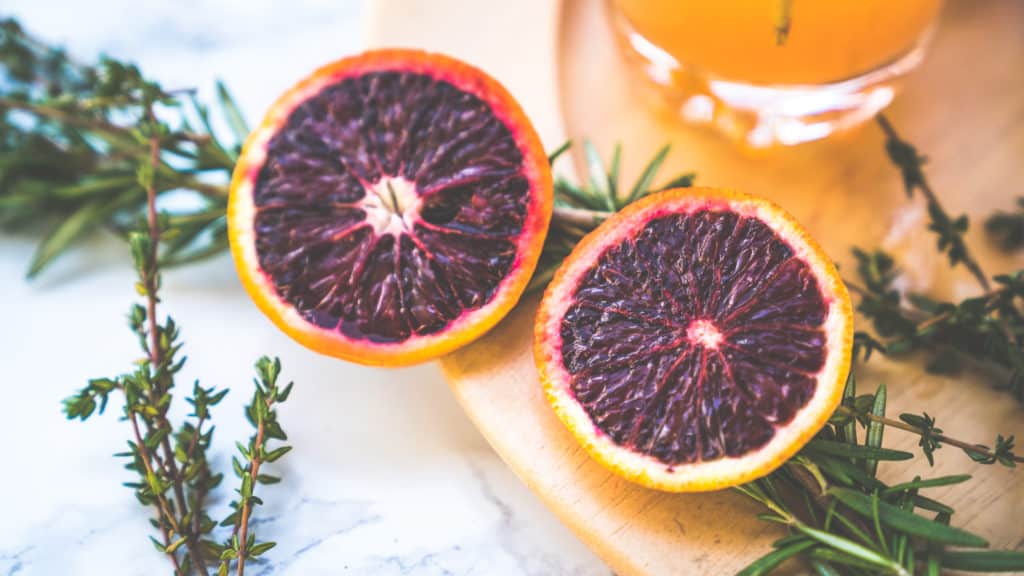
Healthy women have also been shown to absorb and retain calcium just as well from calcium-rich mineral water as from milk.
This may be especially good news for people who are lactose-intolerant – particularly those of Asian, Hispanic and African-American heritage.
In addition, mineral waters may also provide another bone-building mineral, silicon, in amounts ranging from 3.44 to 7.23 mg per half liter.
And shrubs made with calcium-rich mineral water are certainly a much healthier alternative to sodas – especially for young girls and women. Data from the USDA’s Nationwide Food Consumption Surveys shows that milk consumption has decreased by 36% since the late 1970s, while consumption of soda has doubled! This is a particularly unfriendly-to-bone trend in young girls between the ages of 12 and 19 – the years during which bone density accumulation rates are supposed to be at their highest.
Plus, sparkling mineral waters are naturally calorie-free!
High-calcium mineral waters should, therefore, be considered a useful dietary source of bioavailable calcium – particularly given recently published research from Sweden, which I’ve discussed in an article titled Debunking the Milk and Osteoporosis Myth.
In sum, the researchers found that drinking 3 or more glasses of cow’s milk daily might promote bone loss due to the galactose sugar derived from the lactose in cow’s milk. That is, unless you choose lactose-free cow’s milk, which is what I recommend for those who wish to drink several glasses of cow’s milk each day and are not allergic to dairy.
Lastly, drinks made with shrub syrup are really gorgeous!
The Tart Cherry Shrub is a deep red/violet. The Citrus Ginger Shrub is a lovely golden/rose color, a tropical sunset in a glass.
You can add a wee bit of vodka or gin if an alcoholic drink is desired, but these drinks taste wonderful alcohol-free.
For even more calcium and anti-inflammatory phytonutrients, plus some vitamin K2, shrub syrups can also be poured over organic, full-fat plain yogurt from pastured cows. Then, you can top them off with a handful of berries and a tablespoon or two of homemade gluten-free granola – this is Joe’s and my favorite dessert.
Fermented Shrubs – 2 Ways
Tart Cherry-Anise-Hibiscus Shrub
1 tablespoon contains 26 calories, 7 grams carbohydrate, 6 grams sugars, 0 grams fat, fiber, protein.
Ingredients:
- 1 cup organic, unfiltered apple cider vinegar
- ¾ cup raw honey (Manuka honey has the greatest anti-bacterial, anti-inflammatory effects)
- ¼ cup dried hibiscus flowers
- 3 drops anise essential oil
- 1 cup pitted frozen sweet cherries, cut in halves or quarters
- ¼ cup dried tart cherries, diced
Directions:
- In a 2-quart wide-mouth jar with a lid, mix the honey and apple cider vinegar well with a spoon until the honey is dissolved in the vinegar.
- Add the hibiscus flowers, anise oil, frozen sweet cherries and dried tart cherries.
- Stir well to combine, seal the jar and place it in the back of one of the shelves of your refrigerator. Leave for 5 days, taste, and if you’re happy with the flavor, it’s ready to use. If you prefer a deeper flavor, let sit an additional 2 days.
- Strain the shrub, pressing down on the fruit solids to remove as much liquid as possible. Store sealed in a clean, glass jar in the refrigerator for up to 2 months. The flavor will only get better as it matures.
- To serve, add 1-2 tablespoons of shrub syrup to a glass containing 6-8 ounces of Pellegrino. For a cocktail, add an ounce of dry sherry, Lillet or vodka.
Citrus-Ginger Shrub
1 tablespoon contains 19 calories, 5 grams carbohydrate, 6 grams of sugar, 0 grams fat, fiber or protein.
Ingredients:
- 1 small/medium organic pink grapefruit
- 2 organic blood oranges
- 2 organic Meyer lemons
- 1 cup organic, unfiltered apple cider vinegar
- ¾ cup raw honey (Manuka honey has the greatest anti-bacterial, anti-inflammatory effects)
- Organic ginger root, frozen
Directions:
- In a 2-quart wide-mouth jar with a lid, mix the honey and apple cider vinegar well with a spoon until the honey is dissolved in the vinegar.
- Wash the citrus fruits well under running cold water. Using a paring knife or vegetable peeler, remove the outermost layer of the peel on each of the fruits. Try to minimize the amount of white pith removed; it’s bitter. Add the peels to the honey-vinegar mixture.
- After peeling, cut the citrus fruits in half and juice them, which should give you ~3/4 cup of juice. Add this to the peels, honey and vinegar mixture.
- Grate the frozen ginger until you have ~2 tablespoons of freshly grated ginger. Since the ginger is organic, there’s no need to peel it first. Add the grated ginger to the vinegar, honey and citrus peel mixture.
- Stir well to combine, seal the jar and place it in the back of a shelf in your refrigerator. Leave for 5 days, taste, and if you’re happy with the flavor, it’s ready to use. If you prefer a deeper flavor, let sit an additional 2 days.
- Strain the shrub, pressing down on the fruit solids to remove as much liquid as possible. Store sealed in a clean, glass jar in the refrigerator for up to 2 months. The flavor will only get better as it matures.
- To serve, add 1-2 tablespoons of shrub syrup to a glass containing 6-8 ounces of Pellegrino. For a cocktail, add an ounce of gin or vodka.
Have you tried bone-building shrubs before? Let me know in the comments below!
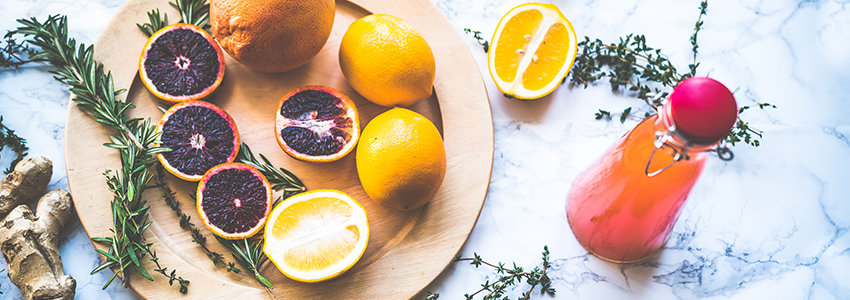
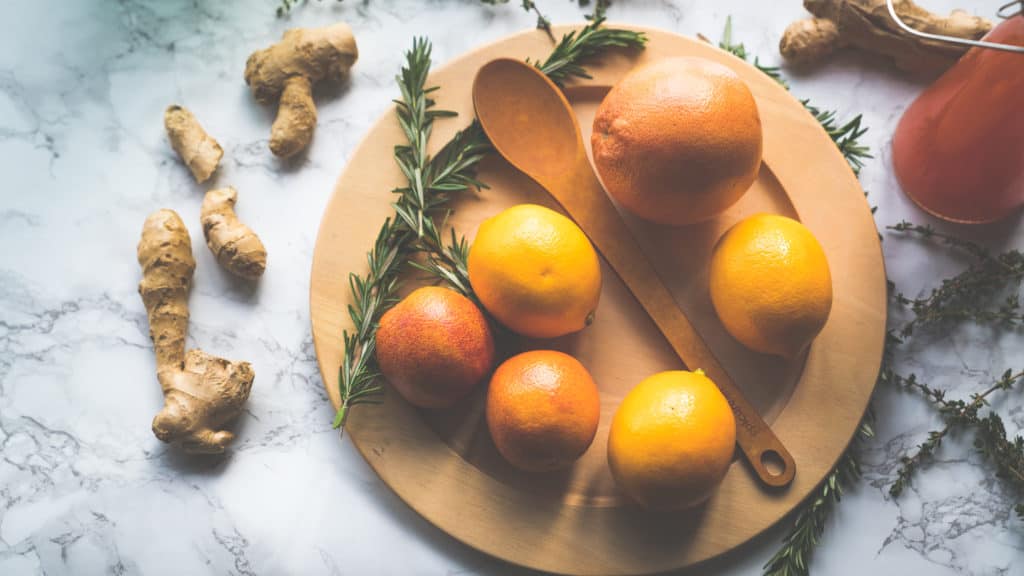
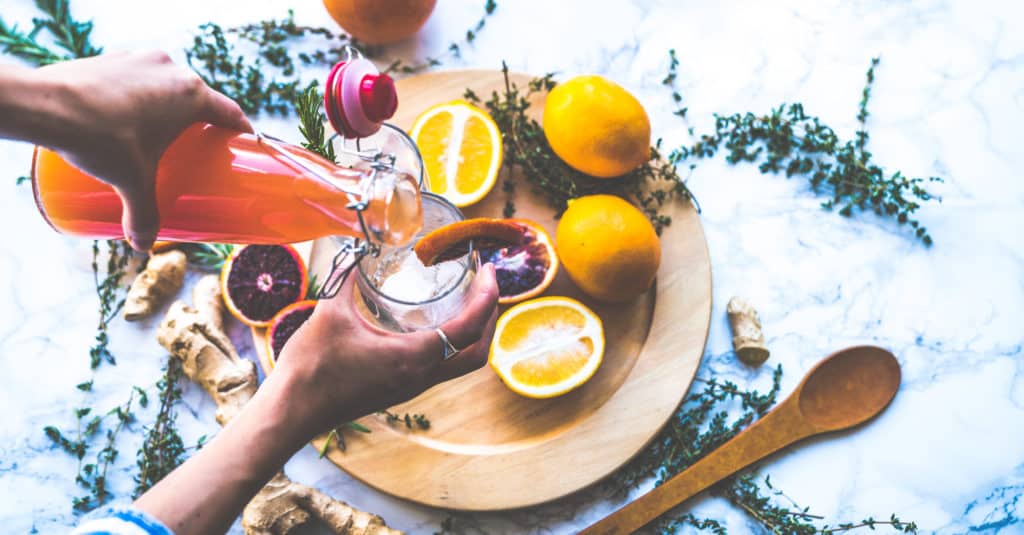
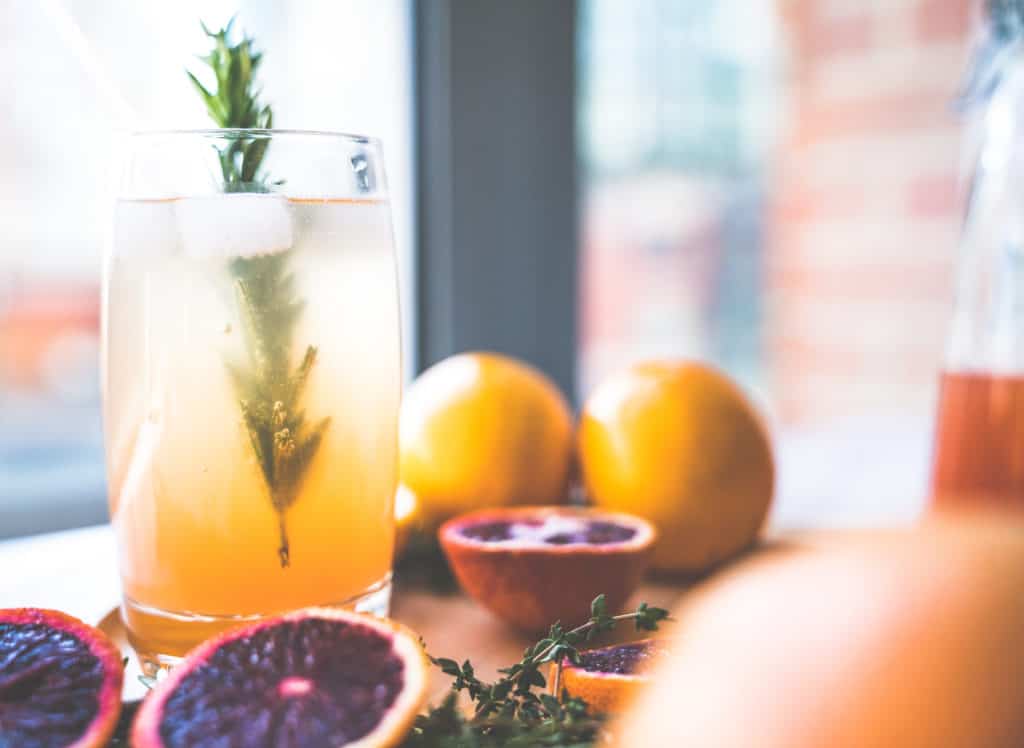




Julie
March 4, 2017 , 10:32 amWhat if you have SIBO and digestive Candida?